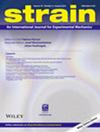激光熔喷后Cu基复合材料表面沉积物中的残余应力
IF 1.8
3区 材料科学
Q2 MATERIALS SCIENCE, CHARACTERIZATION & TESTING
引用次数: 0
摘要
本文章由计算机程序翻译,如有差异,请以英文原文为准。
Residual stresses in Cu matrix composite surface deposits after laser melt injection
Tungsten carbide particles reinforced metal matrix composite (MMC) coatings can significantly improve surface wear resistance owing to their increased surface hardness. However, the presence of macro‐ and micro‐residual stresses in MMC coatings can have detrimental effects, such as reducing service life. In this study, neutron diffraction was used to determine the residual stresses in spherical fused tungsten carbide (sFTC) reinforced Cu matrix composite surface deposits after laser melt injection. We also developed a thermo‐mechanical coupled finite element model to predict residual stresses. Our findings reveal that sFTC/Cu composite deposits produced with a preheating temperature of 400°C have low residual stresses, with a maximum tensile residual stress of 98 MPa in the Cu matrix on the top surface. In contrast, the sFTC/bronze (CuAl10Ni5Fe4) composite deposit exhibits very high residual stresses, with a maximum tensile residual stress in the Cu matrix on the top surface reaching 651 MPa. These results provide a better understanding of the magnitudes and distributions of residual stresses in sFTC‐reinforced Cu matrix composite surface deposits manufactured via laser melt injection.
求助全文
通过发布文献求助,成功后即可免费获取论文全文。
去求助
来源期刊

Strain
工程技术-材料科学:表征与测试
CiteScore
4.10
自引率
4.80%
发文量
27
期刊介绍:
Strain is an international journal that contains contributions from leading-edge research on the measurement of the mechanical behaviour of structures and systems. Strain only accepts contributions with sufficient novelty in the design, implementation, and/or validation of experimental methodologies to characterize materials, structures, and systems; i.e. contributions that are limited to the application of established methodologies are outside of the scope of the journal. The journal includes papers from all engineering disciplines that deal with material behaviour and degradation under load, structural design and measurement techniques. Although the thrust of the journal is experimental, numerical simulations and validation are included in the coverage.
Strain welcomes papers that deal with novel work in the following areas:
experimental techniques
non-destructive evaluation techniques
numerical analysis, simulation and validation
residual stress measurement techniques
design of composite structures and components
impact behaviour of materials and structures
signal and image processing
transducer and sensor design
structural health monitoring
biomechanics
extreme environment
micro- and nano-scale testing method.
 求助内容:
求助内容: 应助结果提醒方式:
应助结果提醒方式:


